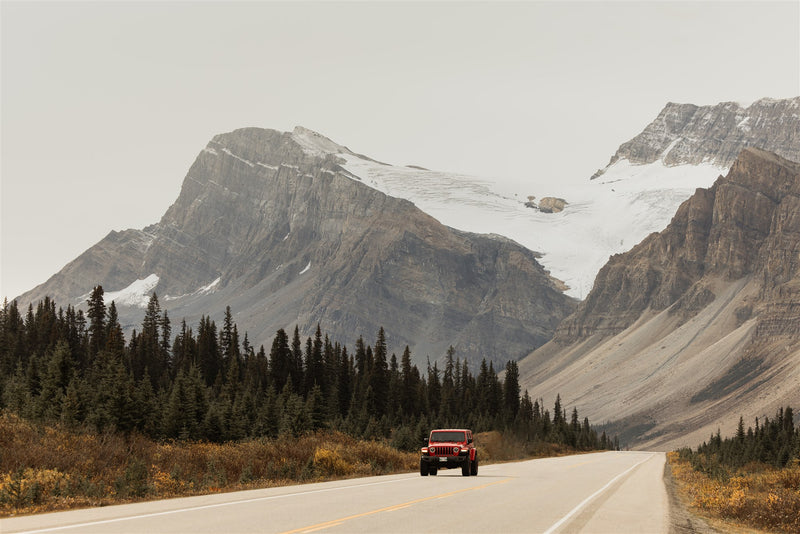Dressing Properly for Overland Adventures in Cold Weather
Overland adventures take us to breathtaking landscapes and push us into ever-changing environments. The allure of venturing off the grid, navigating remote trails, and camping under starlit skies comes with its challenges, especially when temperatures plummet. Dressing appropriately is not just a matter of comfort—it's a matter of safety and preparedness. Here's a comprehensive guide to dressing for cold-weather overland adventures, ensuring you're ready for anything the elements throw your way.
The Importance of Layering
Layering is the cornerstone of any effective cold-weather wardrobe. It provides adaptability, allowing you to adjust to fluctuating temperatures and weather conditions. A proper layering system comprises three main components:
1. Base Layer: Manages moisture by wicking sweat away from your body.
2. Mid Layer: Provides insulation and retains body heat.
3. Shell Layer: Protects against wind, rain, snow, and other external elements.
Each layer serves a distinct purpose, and the right combination ensures that you remain warm, dry, and comfortable throughout your journey.
Layering 101: The Basics
1. The Base Layer
The base layer is your first line of defense against the cold. Its primary function is to wick moisture away from the skin, keeping you dry and preventing the chill that comes from damp clothing.
Material Options:
Merino Wool: A natural, breathable, and odor-resistant material ideal for cold climates.
Synthetic Fabrics: Polyester and nylon dry quickly and are often more affordable.
Avoid Cotton: Cotton absorbs moisture and retains it, increasing the risk of hypothermia.
Tips:
- Choose a base layer weight—light, mid, or heavy—based on the expected activity level and temperature.
- Opt for fitted but comfortable garments to ensure effective moisture management.
2. The Mid Layer
The mid layer is all about insulation, trapping body heat to keep you warm. This layer can range from lightweight fleece jackets to heavier down or synthetic insulated garments.
Material Options:
Down Insulation: Lightweight and highly compressible, but less effective when wet.
Synthetic Insulation: Retains warmth even when damp, making it ideal for unpredictable conditions.
Fleece: Provides warmth while managing moisture effectively.
Tips:
- Pack multiple mid-layer options for varying temperature ranges.
- Ensure the mid layer fits comfortably over your base layer without restricting movement.
3. The Shell Layer
The outermost layer shields you from wind, rain, and snow. A good shell layer is both waterproof and breathable, allowing moisture from your body to escape while keeping external elements out.
Material Options:
- Hard Shells: Durable and protective, ideal for extreme conditions.
- Soft Shells: Provide more breathability and flexibility but are less waterproof.
Tips:
- Look for features like adjustable hoods, zippered vents, and taped seams.
- Invest in high-quality waterproof gear, especially for wet environments.
Cold weather often demands more than the basic three-layer system. Accessories play a crucial role in maintaining warmth and protecting exposed areas.
1. Hats and Balaclavas
- Insulate your head, a significant source of heat loss.
- Opt for fleece-lined or wool hats and wind-resistant balaclavas for extreme conditions.
2. Gloves and Mittens
- Choose insulated gloves for dexterity and warmth.
- Mittens provide better overall warmth as they allow fingers to share heat.
- Consider waterproof outer gloves for added protection.
3. Socks and Footwear
- Wear moisture-wicking, insulated socks made of wool or synthetic blends.
- Invest in waterproof boots with adequate insulation and traction.
- Consider gaiters for deep snow or wet conditions.
4. Scarves and Neck Gaiters
- Protect your neck and face from biting winds.
- Merino wool or fleece options offer warmth without bulk.
5. Eyewear
- Goggles or sunglasses shield your eyes from snow glare and wind.
- Choose lenses with UV protection for high-altitude environments.
1. Understand the Conditions
Research the climate and weather patterns of your destination. Prepare for sudden temperature drops and unexpected precipitation.
2. Focus on Versatility
Choose garments that can serve multiple purposes. For instance, a mid-layer fleece can double as camp wear, and a shell layer can be used in both wet and windy conditions.
3. Test Your Gear
Before embarking on a long trip, test your layering system on shorter outings. This helps identify any fit or performance issues.
4. Stay Organized
Use packing cubes or compression bags to keep clothing layers accessible and compact. This ensures you can quickly adjust to changing weather.
5. Incorporate Everyday Carry (EDC) Essentials
Ensure your outerwear includes space for basic survival items such as:
- A compact fire starter (e.g., flint or waterproof matches).
- A small flashlight or headlamp.
- A multitool or knife for cutting tasks.
- A whistle for signalling.
- A small first-aid kit.
These items can be lifesaving in emergencies and should be readily accessible.
Here are some sample layering setups tailored to specific conditions:
Setup 1: Sub-Zero Conditions
- Base Layer: Heavyweight merino wool top and bottoms.
- Mid Layer: Synthetic insulated jacket.
- Shell Layer: Hard-shell jacket and pants with taped seams.
- Accessories: Insulated gloves, wool socks, balaclava, and waterproof boots.
Setup 2: Damp and Cold
- Base Layer: Lightweight synthetic top and bottoms.
- Mid Layer: Fleece jacket.
- Shell Layer: Waterproof and breathable jacket and pants.
- Accessories: Waterproof gloves, neck gaiter, and insulated boots.
Setup 3: Variable Weather
- Base Layer: Mid-weight merino wool top and bottoms.
- Mid Layer: Packable down jacket.
- Shell Layer: Soft-shell jacket and pants.
- Accessories: Convertible gloves, wool hat, and hiking boots.
Beyond clothing, staying safe in cold-weather overlanding involves other considerations:
1. Hydration and Nutrition
- Drink plenty of water to stay hydrated.
- Consume high-energy foods to fuel your body’s efforts to stay warm.
2. Know the Signs of Hypothermia
- Early symptoms include shivering, fatigue, and confusion. Act immediately by adding layers and seeking shelter.
3. Manage Sweat
- Overheating can lead to sweating, which dampens your base layer. Adjust layers during high-intensity activities to stay dry.
4. Carry Emergency Gear
- Include thermal blankets, fire-starting tools, and a first aid kit in your pack.
E
Cold weather demands particular attention to footwear and lower body protection. Keeping your feet warm and dry is vital for maintaining mobility and overall comfort.
1. Socks
- Layer socks if necessary, starting with a thin moisture-wicking liner followed by a thicker wool sock.
- Ensure there’s enough room in your boots to accommodate layered socks without restricting blood flow.
2. Boots
- Insulated boots with a waterproof outer layer are essential for extreme cold and wet conditions.
- Choose boots with good ankle support and tread for snowy or icy terrains.
3. Pants
- Fleece-lined pants or thermal leggings provide an additional insulation layer.
- Combine with waterproof shell pants to protect against moisture and wind.
4. Gaiters
- Essential for deep snow or wet conditions, gaiters prevent snow or water from entering your boots and pants.
A
For adventurers tackling extreme environments, advanced layering strategies can further enhance comfort and safety.
1. Hybrid Layering
- Use a combination of down and synthetic insulation to balance warmth and moisture resistance.
- For example, a down jacket with synthetic-insulated panels in high-moisture areas.
2. Modular Layers
- Modular systems with removable liners or layers allow for quick adjustments without packing extra gear.
3. Active vs. Rest Layering
- Adjust layers based on activity levels. During high-intensity activities, opt for lighter insulation. Add layers during rest periods to retain heat.
P
Cold-weather overlanding isn’t just about gear—it’s also about mindset and physical readiness.
1. Mental Fortitude
- Staying calm and focused is critical in cold environments. Practice mindfulness and breathing techniques to manage stress.
2. Physical Conditioning
- Prepare your body for the rigours of cold-weather activities with regular exercise and strength training.
- Acclimatize to colder temperatures with short outdoor sessions before your trip.
3. Rest and Recovery
- Adequate sleep is essential for maintaining energy and body warmth. Invest in high-quality sleeping bags rated for extreme conditions. Eating before bed will also provide the body with fuel to help keep you warm, while sleeping.
- Heaters are also available for heating roof-top tents. Be sure to have adequate ventilation if the heater uses gas or diesel fuel.
- Electric blankets are an excellent option for staying warm while sleeping in cold weather, but it's important to be mindful of battery drain, as cold temperatures can deplete batteries more quickly. If you're using an electric blanket or other electrical heaters, ensure your electrical system is designed to handle the additional load. Consider upgrading your battery capacity or incorporating a more efficient power source to maintain sufficient power throughout the night, such as a portable battery pack.
Emergency Clothing and Spare Gear
Always pack spare clothing for unforeseen conditions. A backup set of gloves, socks, or a lightweight insulating jacket can be invaluable if primary gear gets wet or lost.
Integrated Technology in Clothing
Explore advanced clothing options with integrated heating panels or moisture sensors. These technologies can provide extra warmth or notify you when your layers are saturated.
Campsite Clothing Protocol
Reserve a specific set of clothing for camp use to ensure you always have a dry and warm outfit for rest periods. Store these items in waterproof bags to keep them safe from moisture.
When camping, it's essential to prioritize both your safety and the well-being of the environment around you. Two key aspects of campsite safety are wearing the right clothes for cooking and being mindful of wildlife.
Clothing for Cooking
Cooking in camp often involves handling hot surfaces, flames, and potentially hazardous materials. To stay safe, wear protective clothing designed for the task.
This includes:
Heat-resistant gloves: To protect your hands from burns when handling hot cookware.
Long sleeves and pants: These provide a barrier against splashes from hot oils or boiling liquids.
Apron: An apron is an easy, effective option for camp cooking. It protects your clothing and skin from cooking spills and grease. When not in use, store it in a sealed plastic bag to keep it clean and odor-free, ensuring it stays ready for the next meal preparation.
Opt for natural fibre clothing, like cotton or wool, which is less likely to melt or catch fire near open flames.
Wildlife Safety
When camping, it's crucial to respect wildlife and minimize your impact. Wild animals are often attracted to food smells, so follow these safety tips:
Store food properly: Keep food in bear-proof containers or hang it out of reach.
Never leave food unattended at the campsite.
Clean up after meals: Thoroughly clean cookware and eating utensils to avoid attracting animals.
Stay aware of your surroundings: Make noise while hiking or moving around camp to avoid startling wildlife. If you encounter an animal, stay calm and slowly back away.
Always store food and waste securely, far from your sleeping area, to reduce the risk of attracting animals.
By dressing appropriately for cooking and practicing good wildlife safety habits, you ensure a safer and more enjoyable camping experience for yourself and the creatures that share the wilderness with you.
Final Thoughts
Dressing properly for outdoor trips is an essential skill for any adventurer. By building a thoughtful layering system, selecting the right materials, and preparing for the unexpected, you can tackle even the harshest conditions with confidence. Whether you're navigating snow-covered trails or setting up camp in frosty temperatures, the right clothing ensures every moment is as enjoyable and safe as possible. Embrace the cold and let it enhance, not hinder, your overlanding experience.
By investing in quality gear, testing your system, and understanding the unique demands of your environment, you'll create a wardrobe that adapts seamlessly to the challenges of overlanding. Preparation is the key to turning potential hardships into unforgettable adventures. Plan thoroughly, adapt flexibly, and gear up—because the wild awaits.


